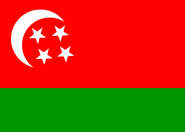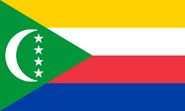| Flag of the Comoros | |

| |
| Adopted | January 7, 2002 |
|---|---|
| Designed by | (unknown) |
| Proportions | 3:5[1] |
The flag of the Comoros consists of four equal horizontal bands of yellow (top), white, red, and blue with a green isosceles triangle based on the hoist; centered within the triangle is a white crescent with the convex side facing the hoist and four white, five-pointed stars placed vertically in a line between the points of the crescent.[2]
Symbolism
- The blue stands for the Grande Comore, which has a mostly blue island flag.
- The red stands for Anjouan, which has a mostly red island flag.
- The yellow stands for Mohéli, which had mostly yellow flags (currently it has a mostly red flag but with a large yellow part, a colour which is missing in all other islands' flags).
- The white stands for the irredentist claim on Mayotte (there is an unofficial arms-on-white flag),
- The green triangle for the federation, whose flags have been almost always mostly green.
- The star and crescent symbol stands for Islam, which is the nation's major religion.
History
In 1908 the islands were declared a dependent territory of the French colony of Madagascar.
In 1961 the Comoros were granted autonomy. In 1963, a flag was adopted for local use, it was green with a white crescent placed in canton and four white stars placed in an ascending diagonal. The flag was designed by the heraldist Suzanne Gauthier, and had aspect ratio 5:7.
In 1975 the Comorian parliament passed a resolution declaring unilateral independence (the deputies of Mayotte abstained), a new national flag was adopted ?— it had a red stripe at the top (for socialism) with the white stars and crescents in the hoist corner, flanked along the bottom edge by a green stripe.
In 1978, president Ali Soilih, who had a firm anti-French line, was killed and Ahmed Abdallah came to power. On September 28, 1995 Bob Denard and a group of mercenaries took over the Comoros islands in a coup against President Djohar.
In March 1996, following presidential elections, Mohamed Taki Abdoulkarim, a member of the civilian government that Denard had tried to set up in October 1995, became president. The constitution of October 3, 1996 (approved by referendum October 20), established yet another flag. The horns of the crescent were again turned, this time toward the fly end of the flag. The Islamic symbolism was reinforced by the addition of Arabic inscriptions—in the upper fly corner ("Allah") and in the lower hoist corner ("Muhammad").
The government was overthrown in a coup by army and navy officers on August 9, 2001. On December 23, 2001, a new constitution was adopted, which prescribed a new flag, hoisted on 31 December 2001.
References
| Nations States with limited/no recognition Territories |





